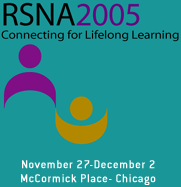
Abstract Archives of the RSNA, 2005
Dongbai Guo PhD, Presenter: Nothing to Disclose
Our goal is to define an XML framework to represent any DICOM objects so that they can be managed, searched, transformed, customized and validated efficiently.
Traditional solutions for XML representation of a DICOM object used a set of monolithic XML schemas to ensure the conformance of an XML document to the DICOM standard. In our previous work, we defined an XML schema such that any XML document that conforms to this schema can be transformed into or generated from a DICOM object. However, such an XML document is not constrained, that is, it may not satisfy the conformance requirements of an application. To solve this problem, we propose an XML specification of conformance constraints (XCC) that can be applied to the XML document to ensure its conformance. We studied the DICOM standard and classified all semantic and syntactic constraints into a set of canonical templates (similar to function call definitions). We demonstrate that these templates can be mapped into XPath definitions and be efficiently implemented by a procedural language such as C or Java. We then define an XML schema to allow the specification of a set of constraints with an XML document (XCC document). An XCC document can be associated with a specific set of SOP classes and defined by a trigger condition. At runtime, we validate an XML document containing DICOM metadata against one or more XCC documents to validate the semantic conformance of its content.
Because the number of different types of canonical templates in an XCC document is small, we can greatly simplify the documentation, construction, and customization of a conformance document. The runtime validation can also be optimized significantly in comparison to a free form constraint language like XPath. Since we separate the encoding and validation of XML documents, the constraints can be modified or customized into an implementation specific set that may be stricter or looser than the DICOM standard. Finally, the validation can be easily turned on or off for a selected set of SOP classes.
Our framework can significantly improve the flexibility, manageability and performance of an XML metadata solution for DICOM objects.
D.G.: Dongbai Guo is an employee of Oracle USA, Inc.
Guo, D,
A Unified Framework for Extensible Markup Language (XML) Encoding and Validation of Digital Imaging and Communication in Medicine (DICOM) Objects. Radiological Society of North America 2005 Scientific Assembly and Annual Meeting, November 27 - December 2, 2005 ,Chicago IL.
http://archive.rsna.org/2005/4412986.html

